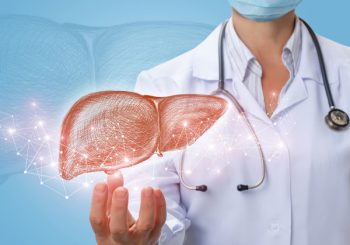By Sayer Ji
Contributing writer for Wake Up World
The liver is the largest organ in the body and helps store energy, digest food and get rid of toxins. Just like in the human body, fat builds up in the liver, leading to fatty liver disease. Liver diseases are considered the second leading cause of mortality among all digestive disorders in the U.S., as well as the fifth most common cause of death.[i]
Fatty liver diseases include non-alcoholic fatty liver disease (NAFLD) and non-alcoholic steatohepatitis (NASH). These two are the most common liver disorders in the industrialized world, accounting for 10% to 46% in the U.S. alone.[ii] According to systematic reviews, the prevalence of NAFLD in adults is around 25% to 33%.
NAFLD is of particular interest as the most common chronic liver disease in children and young people in industrialized nations, mainly due to obesity.[iii] It’s often diagnosed with abnormal liver tests or fatty changes coming up on ultrasound. This liver condition can silently progress and remain asymptomatic, so early detection is key.
NAFLD is also present in more than half of adults with Type 2 diabetes and metabolic syndrome.[iv] Untreated, the disease can progress to fibrosis, cirrhosis and hepatocellular cancer.
Five Ways to Combat Fatty Liver Naturally
1. Curcumin
Curcumin is an anti-inflammatory, antioxidant, antidiabetic and antihyperlipidemic agent, traditionally used for treating liver diseases. It is the main natural polyphenol found in turmeric, used for thousands of years for its multiple health benefits.[v]
A 2020 study found that supplementing with curcumin favorably affected metabolic markers in patients with NAFLD.[vi] Results of the meta-analysis indicated a significant decrease in total cholesterol, LDL cholesterol, fasting blood sugar and waist circumference.
A separate review evaluated the efficacy of curcumin supplementation on liver enzymes in NAFLD patients.[vii] The team found a favorable effect with higher dosage, suggesting “further high-quality studies with large scale and higher dosage” need to be done.
2. Probiotics
Probiotics are deemed a potential therapy for NAFLD. A 2019 systematic review found probiotics are superior to placebo in patients with NAFLD and could serve as a complementary therapy.[viii]
Combined with omega-3 fats, a live multistrain probiotic mixture taken daily for eight weeks by NAFLD patients reduced liver fat, improved serum lipids and metabolic profile and reduced systemic inflammation.[ix] Paired with cholesterol-lowering drugs, probiotics also helped treat atherogenic dyslipidemia linked to NAFLD.[x]
3. Coffee
Inflammation is believed to be a contributor to non-alcoholic fatty liver disease and other chronic diseases such as Type 2 diabetes and heart disease. Coffee, with its strong antioxidant profile, is often used to address the inflammatory conditions underlying NAFLD.
One study on green coffee bean extract showed that the supplement weakened a circulating inflammatory marker mediator, which is linked to lower systemic inflammation.[xi]
In Korean men, increasing coffee intake was linked to a lower incidence of fatty liver, suggesting that increased consumption may protect the organ.[xii] The researchers obtained data from 91,436 male and female subjects, with a mean follow-up period of 2.8 years.
Among animal models, coffee prevented fatty liver disease induced by an unhealthy diet through modulating pathways of the gut and liver.[xiii] “The hepatic and metabolic benefits induced by coffee were accompanied by changes in the gut microbiota,” the researchers wrote.
4. Silymarin
Silymarin is an active extract of milk thistle, an ancient medicinal plant used for treating various liver diseases for centuries. It has been found in studies to effectively reduce disease markers in patients with NAFLD, even exceeding the benefits of drugs such as metformin.[xiv],[xv]
In a randomized trial involving 99 subjects, silymarin (700 milligrams given three times a day for 48 weeks) appeared to reduce liver fibrosis, warranting confirmation in a larger trial.[xvi] It was safe and well-tolerated among the patients, the study concluded.
5. Vitamins D and E
Vitamin D, obtained directly from the sun or via supplementation, may be a good therapeutic option for NAFLD due to its insulin-sensitizing and anti-inflammatory properties. A 2019 study showed that vitamin D supplementation significantly ameliorated metabolic, chemical and inflammatory parameters in NAFLD patients, deserving to be treated as an adjunctive therapy.[xvii]
Low vitamin D levels, too, were associated with the presence of fatty liver disease independent of metabolic syndrome, diabetes and insulin resistance.[xviii]
Vitamin E is also often used in treating NAFLD and non-alcoholic steatohepatitis. In an analysis of five studies, it significantly improved liver function and histologic changes in patients with NAFLD/NASH.[xix] Short term, it was found to significantly enhance abnormal liver enzyme levels in NAFLD patients with metabolic syndrome.[xx]
It can also work synergistically with other therapeutic approaches. Among pediatric NAFLD patients, the antioxidant action of hydroxytyrosol and vitamin E slashed systemic inflammation.[xxi] A 2015 study combined silymarin and vitamin E, concluding that along with a low-calorie diet they can positively affect NAFLD.[xxii] Find nearly 800 abstracts with fatty liver research on GreenMedInfo.com.
References:
[i] Sarin S et al “Global Burden Of Liver Disease: A True Burden on Health Sciences and Economies”
[ii] UCLA Health, Fatty Liver Disease https://www.uclahealth.org/comet/fatty-liver-disease
[iii] National Guideline Centre (UK) “Non-Alcoholic Fatty Liver Disease: Assessment and Management” 2016 Jul.
[iv] National Guideline Centre (UK) “Non-Alcoholic Fatty Liver Disease: Assessment and Management” 2016 Jul.
[v] Hewlings S et al “Curcumin: A Review of Its’ Effects on Human Health” Foods. 2017 Oct; 6(10): 92. Published online 2017 Oct 22.
[vi] Jalali M et al “The effects of curcumin supplementation on liver function, metabolic profile and body composition in patients with non-alcoholic fatty liver disease: A systematic review and meta-analysis of randomized controlled trials” Complement Ther Med. 2020 Jan ;48:102283. Epub 2019 Dec 17.
[vii] Mansour-Ghanaei F et al “Efficacy of curcumin/turmeric on liver enzymes in patients with non-alcoholic fatty liver disease: A systematic review of randomized controlled trials” Integr Med Res. 2019 Mar;8(1):57-61. doi: 10.1016/j.imr.2018.07.004. Epub 2018 Jul 27.
[viii] Xiao M et al “Systematic Review with Meta-Analysis: The Effects of Probiotics in Nonalcoholic Fatty Liver Disease” Gastroenterol Res Pract. 2019 ;2019:1484598. Epub 2019 Dec 11.
[ix] Kobyliak N et al “Beneficial effects of probiotic combination with omega-3 fatty acids in NAFLD: a randomized clinical study” Minerva Med. 2018 Dec ;109(6):418-428. Epub 2018 Sep 13.
[x] Zvenigorodskaia L et al “Advisability of using probiotics in the treatment of atherogenic dyslipidemia” Eksp Klin Gastroenterol. 2011(2):37-43.
[xi] Asbaghi O et al “Effect of green coffee bean extract supplementation on liver function and inflammatory biomarkers: A meta-analysis of randomized clinical trials” Complement Ther Clin Pract. 2021 May ;43:101349. Epub 2021 Mar 4.
[xii] Chung H et al “The increased amount of coffee consumption lowers the incidence of fatty liver disease in Korean men” Nutr Metab Cardiovasc Dis. 2020 Jun 2. Epub 2020 Jun 2.
[xiii] Vitaglione P et al “Coffee prevents fatty liver disease induced by a high-fat diet by modulating pathways of the gut-liver axis” J Nutr Sci. 2019 ;8:e15. Epub 2019 Apr 22.
[xiv] Zhong S et al “The therapeutic effect of silymarin in the treatment of nonalcoholic fatty disease: A meta-analysis (PRISMA) of randomized control trials” Medicine (Baltimore). 2017 Dec ;96(49):e9061.
[xv] Hajiaghamohammadi A et al “Effects of metformin, pioglitazone, and silymarin treatment on non-alcoholic Fatty liver disease: a randomized controlled pilot study” Hepat Mon. 2012 Aug ;12(8):e6099. Epub 2012 Aug 3.
[xvi] Chan W et al “A Randomized Trial of Silymarin for the Treatment of Non-alcoholic Steatohepatitis” Clin Gastroenterol Hepatol. 2017 Apr 15. Epub 2017 Apr 15.
[xvii] Hussain M et al “Effect of vitamin D supplementation on various parameters in non-alcoholic fatty liver disease patients” Pak J Pharm Sci. 2019 May;32(3 Special):1343-1348.
[xviii] Barchetta I et al “Strong association between non alcoholic fatty liver disease (NAFLD) and low 25(OH) vitamin D levels in an adult population with normal serum liver enzymes” BMC Med. 2011 Jul 12 ;9:85. Epub 2011 Jul 12.
[xix] Sato K et al “Vitamin E has a beneficial effect on nonalcoholic fatty liver disease: A meta-analysis of randomized controlled trials” Nutrition. 2015 Jul-Aug;31(7-8):923-30. Epub 2014 Dec 24.
[xx] Kim G et al “Effect of vitamin E in nonalcoholic fatty liver disease with metabolic syndrome: A propensity score-matched cohort study” Clin Mol Hepatol. 2015 Dec ;21(4):379-86. Epub 2015 Dec 24.
[xxi] Mosca A et al “Antioxidant activity of Hydroxytyrosol and Vitamin E reduces systemic inflammation in children with paediatric NAFLD” Dig Liver Dis. 2020 Oct 12. Epub 2020 Oct 12.
[xxii] Aller R et al “Effect of silymarin plus vitamin E in patients with non-alcoholic fatty liver disease. A randomized clinical pilot study” Eur Rev Med Pharmacol Sci. 2015 Aug ;19(16):3118-3124.
Recommended Articles by Sayer Ji:
- The Power and Mystery of Melanin Explained
- Cell Phone Induced Bodily Harm: How the Bees Can Help
- The Spice That Prevents Fluoride Destroying Your Brain
- How to Clean Your Arteries with One Simple Fruit
- 7 Healing Uses for Lavender Essential Oil
- From Table to Tomb: Cumin’s Health Benefits Rediscovered
- Why You Should Ditch Sugar in Favour of Honey
- The Love Affair Between Saffron and Humanity: As Ancient as Time Itself
- Why Walnut Resembles the Brain It Nourishes
- Magnesium Puts Psychiatric Drugs to Shame for Depression
About the author:
Sayer Ji is the founder of Greenmedinfo.com, a reviewer at the International Journal of Human Nutrition and Functional Medicine, Co-founder and CEO of Systome Biomed, Vice Chairman of the Board of the National Health Federation, and Steering Committee Member of the Global Non-GMO Foundation.
© 2020 GreenMedInfo LLC. This work is reproduced and distributed with the permission of GreenMedInfo LLC. Want to learn more from GreenMedInfo? Sign up for their newsletter here.

If you've ever found value in our articles, we'd greatly appreciate your support by purchasing Mindful Meditation Techniques for Kids - A Practical Guide for Adults to Empower Kids with the Gift of Inner Peace and Resilience for Life.
In the spirit of mindfulness, we encourage you to choose the paperback version. Delve into its pages away from screen glare and notifications, allowing yourself to fully immerse in the transformative practices within. The physical book enriches the learning process and serves as a tangible commitment to mindfulness, easily shared among family and friends.
Over the past few years, Wake Up World has faced significant online censorship, impacting our financial ability to stay online. Instead of soliciting donations, we're exploring win-win solutions with our readers to remain financially viable. Moving into book publishing, we hope to secure ongoing funds to continue our mission. With over 8,500 articles published in the past 13 years, we are committed to keeping our content free and accessible to everyone, without resorting to a paywall.








